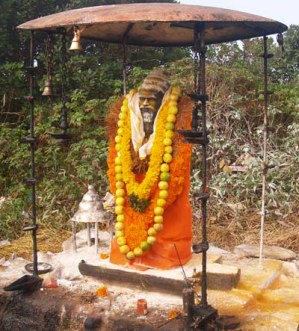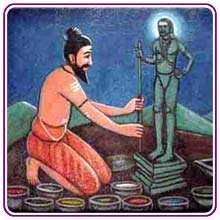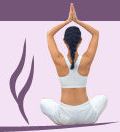Siddha and Drug Free Living
Health is the vital principle of bliss.
The Siddha system of medicine, also known as Siddha Vaidhya in India, is among the oldest medical systems on Earth and is in popular use in parts of Southern India. It's well known for its phenomenal capabilities in bringing the human system to its full efficiency. Most of its literature is in Tamil language. Siddha not only deals with medicine, but also with spirituality, healthy ways of living and rejuvenation. Its ultimate aim is self-realization / enlightenment.
History of Siddha medicine
In Yogic culture, Shiva is not known as a God, but as the Aadhi Guru (first teacher). He is the Aadhi Yogi (first Yogi) and an enlightened one.
Shiva's first teaching was to Paarvathi, his wife. And the second set of Yogic teaching was given to Saptha Rishis, the first seven sages. These seven sages travelled to every corner of the globe, spreading the knowledge of Yoga and Eastern mysticism.
Sage Agasthya was one among those Saptha Rishis. He travelled to Southern India and spread the knowledge of Yoga and Siddha medicine.
He is regarded as the founder of Siddha medicine. He was an exponent not only in Siddha medicine but also in Kalari, especially Thekkan Kalari which is one of the finest martial arts ever known to mankind.

Sage Agasthya in Podhigai hills
(Image courtesy - CNRNair-Wikipedia)
Varmakkalai is a part of Thekkan Kalari. Varma is called as the point of secrets. There are 108 places in the body which are highly dangerous. Either a finger push or a gentle touch in these places can paralyze or even cause death to a person. These vulnerable places can be used to heal or harm.
Along with Sage Agasthya many other Siddhas contributed significantly to the Siddha medicine. They lived in forests, caves and mountains and ate mainly fruits and roots. According to tradition, there were 18 Siddhas (Highly accomplished ones / Perfected human beings):
| 1.Nandi Devar | 2.Agasthya(or)Agasthyar | 3.Thirumoolar |
| 4.Bogar | 5.Konganar | 6.Machamuni |
| 7.Thaeraiyar | 8.Sattaimuni | 9.Agappaei |
| 10.Kaalanginaathar | 11.Kudhambai | 12.Karuvoorar |
| 13.Idaikaadar | 14.Kamalamuni | 15.Punnaakkeesar |
| 16.Pulasthiyar | 17.Azhuganni | 18.Paambaatti |
But there were (and) are many other equally great Siddhas who cannot be contained in this small list.

Mahaaguru Bogar used nine different minerals (Nava Paashaanam) to create Lord Dhandapaani idol in Palani-Tamilnadu
Abhishekam which touches this idol, if consumed, is capable of curing many ailments !
Principles of Siddha medicine
1) Principles of Siddha are similar to that of Ayurveda.
2) Universe is the macrocosm and human is a microcosm in it.
3) Everything in this Universe is made up of the combinations of five elements (Panchamahaabhutas) - Earth, Water, Fire, Air and Ether(Space).
4) The three Doshas, Vaata-Pitta-Kapha regulate all the physiological and psychological processes in a living organism. The interplay among these three forces determines the qualities and conditions of an individual. The equilibrium of the three Doshas is considered as health and the disturbance or imbalance leads to disease.
5) Diet and lifestyle play a major role, not only in health but also in curing diseases. This concept of the siddha medicine is termed as pathiyam and apathiyam, which is essentially a list of do's and dont's.
6) Proper food itself is the medicine.
Diagnosis
Amongst the varied traditional systems, the Siddha diagnostic methodology is quite unique and interesting that includes eight important diagnostic methods namely,
1. Naadi - pulse diagnosis
2. Sparisam - touch diagnosis
3. Naa - tongue examination
4. Varnam - colour of skin examination
5. Svaram - voice examination
6. Vizhi - eye examination
7. Malam - faeces examination
8. Moothiram - urine examination
Medicine and Treatment
In Siddha medicine the usage of metals and minerals is more predominant when compared to other traditional medicine systems.
The medicines prepared by the Siddhas can be classified into three groups:
- Thaavaram (herbal products)
- Thaadhu (inorganic substances)
- Jangamam (animal products)
The Thaadhu medicines are further classified into:
1. Uppu (water-soluble inorganic substances that give out vapour when put into fire)
2. Paashaanam (drugs not dissolved in water but emit vapour under fire)
3. Uparasam (similar to paashaanam but differ in action)
4. Loham (not dissolved in water but melt under fire - metals like gold, silver and lead)
5. Rasam (drugs which are soft)
6. Ghandhagam (drugs which are insoluble in water, like sulphur)
Siddha treatment is classified into three types:
a) Deva maruthuvum (Divine method): Medicines like parpam, chendooram, guru, kuligai(made of mercury, sulphur) and paashaanam are used.
b) Maanuda maruthuvum (Rational method): Medicines made of herbs like churanam, kudineer and vadagam are used.
c) Asura maruthuvum (Surgical method): Incision, excision, heat application and blood-letting (leech therapy) are used.
According to Siddha medicine there are 108 vital points (Varma points) in human body through which Prana flows in a channeled way. Any trauma to these critical points may cause loss of consciousness or convulsions or even death. But gentle vibration or pressure applied in these points relieves the obstruction of the energy flow. This is known as Varma therapy which provides a complete natural healing and rejuvenation.
Yoga (Asanas & Pranayama) is also prescribed for faster healing and maintaining health thereafter.
From Siddha and Drug Free Living to Drug Free Living Home
Like This Page?
